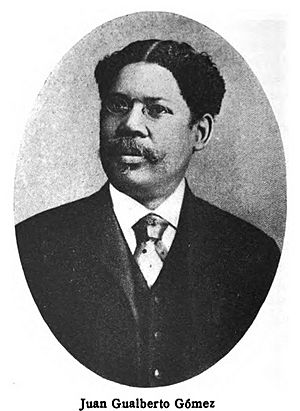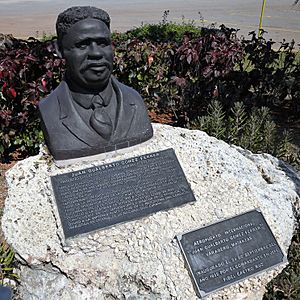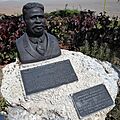Juan Gualberto Gómez facts for kids
Quick facts for kids
Juan Gualberto Gómez Ferrer
|
|
|---|---|

Juan Gualberto Gómez as a Senator in 1919
|
|
| Born | July 12, 1854 |
| Died | March 5, 1933 (aged 78) |
Juan Gualberto Gómez Ferrer (born July 12, 1854 – died March 5, 1933) was an important Afro-Cuban leader. He fought for Cuba's freedom from Spain. He was a close friend and helper of José Martí, another famous Cuban revolutionary. Together, they planned the uprising and united many people, especially black Cubans, to join the fight.
Juan Gualberto Gómez was also a journalist and activist. He started and worked for several newspapers that supported independence and racial equality. He wrote many articles about freedom and justice for people in Latin America. Later in his life, he continued to write and serve in the Cuban government. He helped write the first Cuban Constitution in 1901. He also became a representative and a senator. He is remembered as a key leader for Afro-Cubans in the fight for independence.
Contents
Early Life and Studies
Juan Gualberto Gómez was born on a sugar plantation called "Golden Fleece." His parents, Fermin Gómez and Serafina Ferrer, were enslaved. But they managed to buy their son Juan's freedom before he was born. This was allowed by the laws at the time.
Because he was born free, Juan could learn to read and write. This was rare for black Cubans on plantations back then. His parents sent him to school in Havana, even though it was a financial sacrifice.
In 1868, the Ten Years' War began in Cuba. This was a war for independence from Spain. There was a lot of violence. After Juan got into a fight between people who supported Spain and those who wanted independence, his parents sent him to France. They wanted him to be safe. He went to study how to build horse carriages, which was one of the few jobs open to black and mixed-race people. He did so well that he later studied engineering.
In 1872, some Cuban independence leaders came to Paris. They needed a translator, and Juan was hired. This was his first connection to the independence movement. But life in France became hard, and his parents could no longer send him money. Juan didn't want to return to Cuba. So, he found low-paying jobs as a reporter for newspapers. This was the start of his long career in journalism.
Juan Gualberto Gómez started writing news and opinions, first for money, then because he believed in the cause. By 1877, he was known as a strong journalist, debater, and public speaker. In 1878, he went to Mexico. There, he met Nicolas Azcarate, a Cuban who was against slavery. Juan learned that the Ten Years' War had ended, and Cuba was still under Spanish rule. Many Cubans who had left the country started to return home. Juan Gualberto Gómez also moved back to Havana in late 1878.
The Fight for Independence
Back in Havana in 1878, Juan Gualberto Gómez met José Martí. They quickly became close friends because they shared the same ideas about Cuban freedom. They began to plan a new uprising against Spain. Both men became secretaries for different revolutionary groups in Havana.
In 1879, Gómez started a newspaper called The Brotherhood. It promoted racial justice. But its publication stopped when he was sent away to Spain. This happened because he was involved in the Little War, another attempt at rebellion.
Juan Gualberto Gómez spent ten years in Madrid, Spain. He wrote for many newspapers there. These included Tribuna, El Pueblo, and El Progreso, which supported the Spanish republican movement. He also wrote for other journals, like Abolitionism, which fought against slavery.
After returning to Cuba in 1890, Martí gave Gómez an important job. He was to prepare for the upcoming uprising in the Havana area. Gómez managed to organize the war preparations right under the noses of the Spanish authorities. On February 24, 1895, Martí gave the order for the armed uprising to begin. Gómez helped lead a failed uprising in Matanzas. The rebellion was slow to start and didn't get much support at first.
On February 28, Spanish forces captured Gómez. He was sentenced to 20 years in prison in Spain. However, he only spent three years there. After being released, Gómez moved to New York City. He continued to work with other Cuban revolutionaries. In 1898, he went to Washington, D.C., with General Calixto García. They were part of a group trying to get money and recognition for the Cuban Liberation Army.
Later, during a second time when the U.S. military was in Cuba (1906–1909), Gómez was part of a committee. This committee was tasked with changing the Cuban constitution. He spoke out strongly against the U.S. influence. He famously said that the Platt Amendment made Cuba's independence "a myth." He served in the Cuban House of Representatives (1914–1917) and the Senate (1917–1925). He always worked to protect Afro-Cubans from unfair treatment and violence.
Fighting for Racial Equality
During the Ten Years' War and afterward, Spain tried to divide Cubans by race. They said they were protecting "white civilization" from black people. Spain claimed black Cubans would cause a slave revolt like in Haiti. Juan Gualberto Gómez knew that racism was a huge problem that Cubans had to solve. They needed to unite to win independence from Spain. It wasn't enough to end slavery. They also had to end prejudice and public discrimination. This was key to getting Afro-Cubans to support independence.
When Juan Gualberto returned to Havana in 1877, he began his work as an activist. He fought not only for Cuba's freedom but also for racial equality. In April 1879, his newspaper The Brotherhood started. Its motto was "General Journal for the defense of the colored race in Cuba." Through this newspaper, he showed examples of unfair treatment and discrimination against black and mixed-race people.
In one article from 1888, he reminded readers: "yesterday we were slaves, today we are free, we want to participate in life, claim our rights, we want consideration and respect." The Brotherhood reported on the daily lives and concerns of the black population. It even published letters from people sharing their problems. The Brotherhood helped Juan Gualberto gain many supporters across the island. He became known as Cuba's first true voice and defender of black people.
Juan Gualberto also strongly supported black veterans of the War of Independence. He fought for them to receive public benefits and recognition. Serving in Cuba's founding war gave Afro-Cubans a new way to demand their rights as citizens. Groups like the "Committee of Veterans and Association of the Colored Race" helped black veterans. These war heroes, both famous and ordinary soldiers, used their status as freedom fighters. They demanded voting rights, laws against discrimination, and government jobs. Juan Gualberto urged people to meet their demands. He said, "we do not forget the sacrifices of the petitioners in the very recent revolutionary past, a time when skin color was of no importance, but quality and individual virtues were of great importance."
By the 1890s, Gómez was the most important Afro-Cuban leader. He led the Central Directorate of Societies of the Colored Race. This group brought together about 100 black organizations. They successfully campaigned for civil rights. They helped get Spanish laws passed that ended restrictions on mixed-race marriage. They also ended government segregation in schools and other public places. The Central Directorate played a very important role in the fight for racial equality. It also helped black activists gain valuable experience in organizing and politics.
However, these new laws from Spain didn't change things much in real life. Many towns still had "separate but equal" areas for black people in public parks. Many businesses still had "whites only" signs. Because of this, most politically active Afro-Cubans still wanted to break away from the Spanish government. When the third war for independence started in 1895, most of the activist groups closed. Their members joined the revolution and left their communities.
Even after Cuba gained independence, progress against discrimination was slow. Many felt that an independent political party for Afro-Cubans was needed. But Juan Gualberto was always against forming a black party. He held this view throughout his political life. This position became very controversial, and he lost some popularity among fellow Afro-Cubans.
After the first years of the republic, nothing was done to promote integration or end discrimination. In the 1908 elections, not one black candidate from the two main political parties was elected. This made many black and mixed-race Cubans very unhappy. It became clear that black Cubans could not rely on the existing political parties. So, important Afro-Cubans formed the first black political party in Cuba. It was called the Partido Independiente de Color (PIC), or Independent Colored Party. Juan Gualberto Gómez was not part of this group.
Juan Gualberto Gómez and Martín Morúa Delgado were the two most famous black Cuban congressmen at the time. They both opposed the PIC from the start. They argued that Cuba had a history of racial harmony, which they used to try and stop the Independientes. Most established Cuban politicians, both black and white, were against the PIC. They worried it would take away some of their power and support.
Advocacy in the Early Republic
After Cuba became a republic on May 20, 1901, Juan Gualberto Gómez continued his fight. Writing under the name "G," he strongly opposed Tomás Estrada Palma, Cuba's first president. He also fought against the Platt Amendment. He believed this amendment made Cuba almost a colony of the United States. His articles attacked corruption and politicians who seemed to give in to U.S. power. He always highlighted those who stayed true to José Martí's ideas.
Death
Juan Gualberto Gómez died on March 5, 1933, at 78 years old. To honor him, the Union of Journalists of Cuba created an annual prize in his name.
The international airport in Varadero (VRA) is also named the Juan Gualberto Gómez Airport in his honor.
Images for kids
See also
 In Spanish: Juan Gualberto Gómez para niños
In Spanish: Juan Gualberto Gómez para niños




